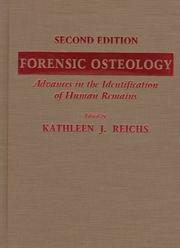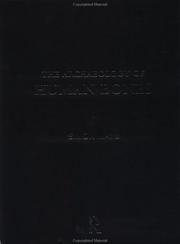| Listing 1 - 2 of 2 |
Sort by
|

ISBN: 0398080747 9780398080747 0398068046 9780398068042 9780398078768 9783868676204 9781786981103 Year: 1998 Publisher: Springfield, Ill. Charles C Thomas
Abstract | Keywords | Export | Availability | Bookmark
 Loading...
Loading...Choose an application
- Reference Manager
- EndNote
- RefWorks (Direct export to RefWorks)
The most recent advances in human identification are thoroughly discussed in this important new text. The twenty-five contributions to this volume demonstrate movement beyond the boundaries of forensic anthropology of only a decade ago. In Chapter 2 the role of the forensic anthropologist at scenes containing human victims, including multiple fatality incidents, fires, and serial murder investigations, is discussed. In Chapter 3, the role of the forensic anthropologist is examined in a unique type of recovery situation: death investigative work involving human rights violations. Chapter 4 discusses the cremation process and how it impacts the forensic anthropologist's role in analyzing remains. In Chapter 5, postmortem interval is discussed as well as the factors affecting decomposition, and the author provides a practical overview of recent techniques in determining time since death. Chapters 6 and 7 also discuss postmortem interval related to outdoor death scenes and assessment of time since death under markedly different environmental conditions. In Chapter 8, an overview of the morphological and metric metric approaches to sex estimations from skeletal remains is provided. Other chapters in this part discuss the criteria for sex and age determination of feral and neonatal material, as well as the Suchey-Brooks method and the pubic aging system. Other chapters in the book discuss the following topics: The Application of Histological Techniques for Age at Death Determination; A Multimedia Tool for the Assessment of Age in Immature Remains: The Electronic Encyclopedia for Maxillo-facial, Dental and Skeletal Development; Regression Formulae for Estimating Age at Death from Cranial Suture Closure; Craniofacial Criteria in the Skeletal Attribution of Race; The Timing of Injuries and Manner of Death; Recognizing Gunshot and Blunt Cranial Trauma Through Fracture Interpretation; Postmortem Dismemberment; Saw Marks in the Bones; Statistical Interpretation in Forensic Anthropology; The Forensic Data Bank; Technical Aspects of Identification of Skeletal Markers of Occupational Stress; Facial Approximation; The Evolving Role of the Microscope in Forensic Anthropology; and The Third Exhumation of Jesse Woodson James.
Forensic anthropology. --- Forensic osteology. --- Anthropologie légale --- Ostéologie légale --- Forensic anthropology --- Forensic Medicine --- Bone and Bones --- Anthropology, Physical --- Forensic Dentistry --- Dentistry, Forensic --- Jurisprudence --- Physical Anthropology --- Bone --- Bones --- Bones and Bone --- Bones and Bone Tissue --- Bony Apophyses --- Bony Apophysis --- Condyle --- Bone Tissue --- Apophyses, Bony --- Apophysis, Bony --- Bone Tissues --- Condyles --- Tissue, Bone --- Tissues, Bone --- Skeleton --- Medicine, Forensic --- Medicine, Legal --- Legal Medicine --- Law Enforcement --- Biometric Identification --- DNA Contamination

ISBN: 0415174074 0415166217 9781315171821 1315171821 9781351696005 1351696009 9781351696029 1351696025 9781351696012 1351696017 9780415174077 Year: 1998 Publisher: London New York Routledge
Abstract | Keywords | Export | Availability | Bookmark
 Loading...
Loading...Choose an application
- Reference Manager
- EndNote
- RefWorks (Direct export to RefWorks)
"The Archaeology of Human Bones provides an up to date account of the analysis of human skeletal remains from archaeological sites, introducing students to the anatomy of bones and teeth and the nature of the burial record. Drawing from studies around the world, this book illustrates how the scientific study of human remains can provide answers to important archaeological and historical questions. This new edition reflects the latest developments in scientific techniques and their application to burial archaeology. Current scientific methods are explained, alongside a critical consideration of their strengths and weaknesses. The book has also been thoroughly revised to reflect changes in the ways in which scientific studies of human remains have influenced our understanding of the past, and has been updated to reflect developments in ethical debates that surround the treatment of human remains. There is now a separate chapter devoted to archaeological fieldwork on burial grounds, and the chapters on DNA and ethics have been completely rewritten. This edition of The Archaeology of Human Bones provides not only a more up to date but also a more comprehensive overview of this crucial area of archaeology. Written in a clear style with technical jargon kept to a minimum, it continues to be a key work for archaeology students"--
Anthropométrie --- Paleopathologie --- Paléopathologie --- Pathologie [Paleo] --- Pathologie [Paléo] --- Skeletal remains --- Forensic anthropology --- Restes humains (Archéologie) --- Anthropologie légale --- Methodolgy --- Paleopathology. --- Restes humains (Archéologie) --- Anthropologie légale --- Paléopathologie --- Anthropometry. --- Human remains (Archaeology) --- Methodology. --- Anthropometry --- Paleopathology --- Anthropométrie --- Méthodologie --- Methodology --- Human remains (Archaeology) - Methodology. --- Medical archaeology --- Pathology --- Skeletal remains (Archaeology) --- Human skeleton --- Primate remains (Archaeology) --- Physical anthropology --- Body size --- Bioarchaeology --- Methodolgy.
| Listing 1 - 2 of 2 |
Sort by
|

 Search
Search Feedback
Feedback About
About Help
Help News
News